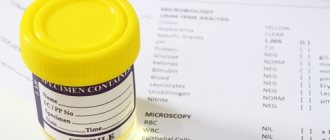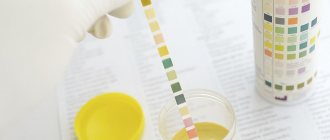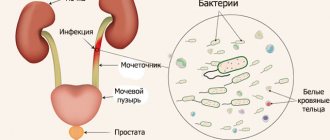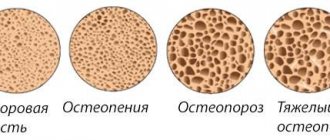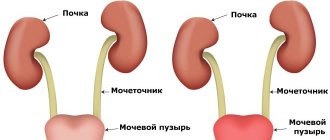Why do a urine test according to Zimnitsky?
The kidneys daily cleanse the blood of metabolic end products, toxins, and delay the components of their breakdown.
The ability of the kidneys to concentrate urine depends on hemodynamic function, nervous regulation, the nature of renal blood flow and other factors. Disturbance in any of the kidneys and renal structures leads to nephrological pathologies, including organ failure. Urine analysis according to Zimnitsky helps diagnose diseases of the kidneys and genitourinary system
Frequent indications for laboratory testing of urine according to Zimnitsky are:
- acute or chronic kidney inflammation;
- glomerulonephritis;
- arterial hypertension;
- gout.
The analysis is also carried out in patients with a burdened nephrological history in order to assess and monitor the dynamics of renal function. In pediatric practice, due to the specificity of urine collection, such an analysis is often prescribed for children older than one and a half to two years. During pregnancy, the analysis is of a clarifying nature if, based on the results of other tests, significant doubts remain.
Further actions
The magnitude of the deviation from a certain norm and its results can prevent the formation of many pathologies, ranging from diabetes mellitus to cirrhosis of the liver. The indicators are considered separately, and their proportions are interpreted. If the analysis reflects the presence of a disease, additional examinations are carried out to accurately confirm the results obtained.
When the interpretation is completed, the patient is given a referral either for further examination or for consultation with a specialist and adjustment of treatment in order to even more actively influence the body.
Conducting a urine test according to Zimnitsky is a guaranteed way to improve a person’s health; doctors will be able to make a diagnosis with its help, as well as carry out prevention and treatment of the disease, if any.
Decoding the results
Equal volumes of daytime and nighttime urination are a sign of renal failure (dysfunction of the concentrating ability of the kidneys). The same volume of urine in collected portions indicates a violation of the kidneys’ ability to adapt to changing environmental conditions during the day.
As the decoding of the Zimnitsky test shows, a reduction in the relative density of urine in each portion (including night portions), the absolute values of which are not more than 1020 g/l, indicates renal and heart failure (with hydronephrosis, glomerulonephritis, renal amyloidosis), diabetes insipidus, exacerbation pyelonephritis, diet low in salt and protein. Low density is referred to as hyposthenuria.
High urine density (above 1035 g/l in one sample) is called hypersthenuria. It can occur with accelerated breakdown of red blood cells (hemolysis, blood transfusion, sickle cell anemia), chronic or acute glomerulonephritis, nephrotic syndrome, diabetes mellitus, toxicosis of pregnancy.
Urine testing according to Zimnitsky is an indicator of the concentrating ability of the kidneys. It is usually prescribed for clinical signs of renal failure, chronic glomerulonephritis, pyelonephritis, hypertension and suspected diabetes insipidus. This analysis allows you to determine the density, daily volume of urine and its distribution during the day (how much volume is excreted during the day and how much at night). If you have indicators of daily fluctuations in diuresis, you can determine a number of disorders in the functioning of the kidneys and heart. During the analysis, the amount of liquid drunk is taken into account. Normally, daily diuresis is 65-80% of its volume (1-2 l), and daytime diuresis should be twice as high as nighttime.
Zimnitsky analysis in children
Collecting urine for Zimnitsky analysis in children is no different from a similar procedure in adults.
The main problem with collecting urine in infants is that the child does not warn about his desire to urinate. Special means for collecting urine, sold in pharmacies and consisting of bags (urinal bags) that are glued to the external genitalia of children, can help collect urine from infants. Next, the baby is put on a diaper and lives as usual. After each urination, urine from the bag is collected in a suitable jar and placed in the refrigerator. Collecting urine from older children becomes easier: it is necessary to explain to the child in detail what is required of him, and also to ensure that all urine is collected in the appropriate jars in a timely manner. The norms for the volume and density of urine in a child differ from adult norms. Norms of daily urine volume in children
| Age | Norm |
| Newborns | 30-60 |
| up to 10 days | 100-300 |
| 10-60 days | 250-450 |
| 1-3 years | 500-600 |
| 3-5 years | 600-700 |
| 5-8 years | 650-1000 |
| 8-14 years | 800-1400 |
Normal urine density in children should be 1013-1025 g/l.
Any deviation from the norm may indicate the presence of kidney disease or diabetes mellitus in the child and is subject to careful analysis by the attending physician (additional studies are prescribed).
How to collect and take a urine test according to Zimnitsky
No specific preparation is required for collecting materials for analysis. It will be enough to follow the normal diet algorithm and follow some recommendations to avoid false results:
- do not use diuretics and artificially increase the volume of water consumed;
- before collecting sample material, do not drink more than 1.5 liters of water;
- exclude from the menu products with coloring pigments (beets, carrots);
- Avoid eating salty, spicy and other foods that increase thirst.
The daily norm is collected, and therefore you will need to prepare 8 containers. All portions will need to be signed and timed. Every 3 hours, starting from 6 am, you should urinate into the appropriate container, the last collection should be before the same period the next day. If, in any of the 3-hour periods, there was no urge to go to the toilet, then the jar should be returned empty to the laboratory.
It is necessary to understand that the daily norm is collected, divided into time intervals. Therefore, it is not allowed to empty the bladder during this period in a place other than the appropriate jar. If any of the containers is overfilled, an additional empty jar is taken and labeled in the same way.
When submitting test material during pregnancy, it is required to take into account and record the amount of water consumed, including liquid meals and various drinks. This will allow specialists to correctly interpret the results.
- Urine analysis according to Zimnitsky: how to collect, what it shows, the norm in children
24.Technique for inserting a gas tube into an infant
Manipulation – Technique for inserting a gas tube into an infant. Purpose: therapeutic. Indications: flatulence. Contraindications: rectal prolapse, acute inflammatory, purulent, ulcerative processes in the anus and colon, fissures in the anus and its gaping, diaper rash in the anus 2-3 degrees, peritonitis, gastrointestinal bleeding, the first days after surgery abdominal organs. Equipment: A – sterile: gas outlet tube, tray, napkins, tweezers, gloves; B – tray with water, Vaseline, Vaseline oil, vegetable oil, phantom doll, gauze balls, powder or baby cream, 3 diapers, oilcloth, disinfectant solution.
Technique for inserting a gas outlet tube: Preparation for the procedure: 1. Place on the changing table sequentially from top to bottom: – diaper, – oilcloth – diaper; 2. Check the presence of a jar of Vaseline, a glass of water, and gauze swabs at the workplace; 3. Provide psychological preparation to the child (mother), explain the procedure; 4. Wash your hands; 5
Put on gloves; 6. Take a sterile tray with tweezers: – place a sterile napkin; – take a sterile gas outlet tube and place it in a napkin; – place the tray on the changing table; – unwrap or undress the child; – lay him on his back or left side, bending his legs at the hip and knee joints. ATTENTION! Before inserting a gas outlet tube, do a cleansing enema. Performing the procedure: 1. Take the gas outlet tube with your right hand, lubricate its rounded end with Vaseline or oil (watering method). 2
Spread the child's buttocks with 1-2 fingers of your left hand, with your right hand, using rotational movements, effortlessly insert the gas outlet tube into the rectum 8-10 cm (for a child in the first months of life) so that its outer end protrudes from the anus. 3. Dip the outer end of the gas outlet tube into a glass of water, 4. check the passage of gases by the presence of bubbles in the water, 5. Cover the child with a diaper, 6. Leave the gas outlet tube for 20-30 minutes until the gases pass, 7. Note: in for 30 minutes, give the child a light abdominal massage clockwise through a warmed diaper, 8
After 30 minutes, carefully remove the gas outlet tube from the rectum, 9. Place the gas outlet tube in the disinfectant solution. Completion of the procedure: 1. After removing the gas outlet tube, treat the circumference of the anus with a gauze ball, treat the skin in the anus with baby powder or cream, 2
Swaddle or dress the baby and place him in the crib. Infection control: 1. Remove gloves and immerse them in 3% chloramine solution for 60 minutes, 2. Soak the gas outlet tube in 3% chloramine solution for 60 minutes. 3. Wipe the oilcloth twice with 1% chloramine solution, 4. Treat your hands at a hygienic level. Note: after 3 hours the procedure can be repeated.
How to store urine for analysis according to Zimnitsky
The Zimnitsky test cannot be taken if you are at home. To do this, the patient will need to come to the laboratory every 3-4 hours to give a sample. A person comes to a medical facility for 1 day, where he empties his bladder 8 times a day into a selected container.
Immediately after collecting the Zimnitsky sample, it is handed over to a nurse or laboratory assistant.
Urine should not be stored for a long time at room temperature or on the refrigerator door.
Only in this case will the doctor receive reliable results.
Preparation, collection and transportation of urine for bacteriological examination
It is advisable to collect biomaterial before using antibacterial, antifungal or immunobiological therapy. If treatment is prescribed, it is recommended to complete the course and then conduct an analysis after 10-14 days.
- Urine is collected STRICTLY in sterile containers, observing hygiene rules
- After thoroughly toileting the external genitalia, without touching the body with the sterile container, collect a medium portion of morning urine (release a little urine, stop urinating and then collect 3-5 ml in the container).
- A lidded container with biomaterial is delivered to the laboratory. If rapid transportation is not possible, it is permissible to store the biomaterial at a temperature (+4...+8°C) for no more than 24 hours.
Analysis transcript
Interpretation of the analysis results is carried out only by a specialist. Deviation from the norm of any indicator requires the close attention of a doctor.
Table: what deviations from the norm indicate
| Indicators | Suspected diseases |
| The amount of daily urine is more than 2 liters (polyuria) |
|
| The amount of daily urine is less than 1.5 l (oliguria) |
|
| Excess of nighttime urine volume over daytime (nocturia) |
|
| The density of urine in one or more jars is above 1035 g/l (hypersthenuria) |
|
| Urine density in all jars is below 1012 g/l (hyposthenuria) |
|
Equally low values in all eight samples (isohyposthenuria) also indicate a deviation in kidney function. Maximum fluctuations in urine specific gravity of less than 0.012–0.016 are one of the early signs of renal failure. Suspected diseases are chronic glomerulonephritis, hypertension, development of amyloid-wrinkled kidney, hydronephrosis, severe polycystic kidney disease.
Low density of urine in samples according to Zimnitsky may have nutritional reasons - long-term adherence to a salt-free or protein-free diet.
Deviations of some indicators from the norm are not necessarily pathological. Increased urine output can be observed when edema subsides, diuretics are taken, or excess fluid is drunk. A small amount indicates the formation of edema, insufficient fluid intake, and increased sweating.
Urine samples according to Zimnitsky are designed to detect renal pathologies at an early stage. It is impossible to track the progression of the disease using this analysis. Even with the progression of the disease and an increase in the content of nitrogenous waste in the blood, the relative density of urine can remain at the same level for a long time.
Decoding the Zimnitsky test: norms and causes of deviations
| Parameter | Norm |
| Total volume of urine excreted per day | 1.5-2 l |
| Ratio of fluid intake to urine output | 65-80% |
| Volume of urine excreted during the day | 2/3 |
| Volume of urine excreted at night | 1.3 |
| Specific gravity fluctuations | 1003-1035 g/l |
| Specific gravity of urine in several or one container | more than 1020 g/l |
| Specific gravity of urine in all containers | less than 1035 g/l |
DETAILS: Clavicle fracture - proper first aid
In addition, it is normal to experience a noticeable increase in urine output after drinking water, other liquids and liquid meals.
With many systemic diseases, the concentrating ability of the kidneys is also affected, and a urine test shows this.
Guest, have you already read the new issue of the magazine “Directory of the Head of KDL”?
| Indicator values | Violation | Possible diseases |
| The specific gravity of urine is less than 1012-1013 g/l in all containers | Hyposthenuria (low urine density) |
|
| The specific gravity of urine in one of the jars is more than 1035 g/l | Hypersthenuria (high density urine) |
|
| The daily volume of urine is more than 2 liters, accompanied by low density, or the daily volume of urine exceeds 80% of the fluid consumed per day | Polyuria |
|
| The daily volume of urine is more than 1.5 liters, accompanied by low density, or the daily volume of urine exceeds 65% of the fluid consumed per day | Oliguria |
|
| The volume of urine excreted at night exceeds 1/3 of the daily volume of fluid consumed | Nocturia |
|
It is important to remember that in order to obtain the most reliable and accurate research result, technically correct collection of biological material is important. The information value of the analysis is reduced if urine is spilled into the toilet or the patient forgets to write down how much liquid he consumed and when.
Repeated urine analysis allows you to monitor the patient’s condition and evaluate the effectiveness of the therapy.
The main diagnostic value of the Zimnitsky analysis is that it allows for differential diagnosis of lesions of the tubular and glomerular systems of the kidneys.
You can also confirm the acute or chronic nature of the pathology.
Knowing how to correctly collect a urine test according to Zimnitsky makes this procedure easy and informative.
The main diagnostic value of the analysis is that it allows for differential diagnosis of lesions of the tubular and glomerular systems of the kidneys.
Material tested by Aktion Medicine experts
A urine sample according to Zimnitsky is deciphered according to two criteria:
- amount of liquid;
- urine density.
First, the doctor measures the volume of fluid. Of course, it will be different at different ages. The older the child, the closer his indicators are to adult norms. For adults, the daily amount of urine should be 1.5-2 liters. The child's urine volume should range from 65% to 80% of the water he drinks.
The amount of liquid in each jar is 50-350 ml. In each container the volume should be different with a tendency to increase. The ratio of nighttime and daytime diuresis plays an important role. Normal proportions are 1:3 - three times more urine is released during the day than at night.
Another, important indicator by which a sample is deciphered is density. Density shows how well the kidneys cope with metabolic function. Normally, the density coefficient ranges from 1.013-1.025 g/ml. In children, the indicator varies by 10 points.
Density is affected by the amount of water you drink per day. It shows the content of elements dissolved in urine - salts, ammonia, protein. A person drinks more during the day than at night, so daytime urine is less dense. Urine has the highest density during morning urination, immediately after waking up.
To decipher the analysis, indicators of the relative density and volume of urine are considered.
Daily diuresis
Normally, 1.5-2 liters of urine are excreted per day. In healthy people, this figure is 2/3 of the volume of fluid drunk per day.
An increase in the number of urinations with a total volume of more than two liters per day is called polyuria. The causes of polyuria are associated with the use of diuretics, swelling, diseases of the kidneys and endocrine glands.
Oliguria - diuresis less than 500 ml per day. It is observed with loss of fluid through vomit, diarrhea, increased edema, disruption of the kidney structure, narrowing of the lumen of the ureters due to compression from the outside (prostate adenoma).
Anuria is a pathological condition with urine output up to 50 ml per day. It occurs due to impaired blood flow in the kidneys, damage to the parenchyma of the organ and blockage of the urinary tract by a tumor or stone.
Physiologically, the amount of urine excreted during the daytime exceeds the volume of nighttime diuresis by 3-4 times. If parts of the night portion make up more than 40% of the total volume, they speak of nocturia. This condition is a consequence of impaired blood flow in the kidneys due to cardiovascular pathology, renal failure, and diseases of the nervous system.
Normally, the volumes in each of the collected portions range from 30 to 400 ml.
Fluctuations in the level of urine density during the day are 1.008-1.025 with a minimum difference in portions of 0.012-0.016. This indicates an adequate ability of the kidneys to concentrate urine under different conditions.
What does the change in density show:
- Hyposthenuria is a change in the qualitative composition of urine, characterized by a decrease in its relative density in the range of 1.002-1.012. Reflects disturbances in the concentration of urine by the kidneys. It is diagnosed when edema resolves, diuretics are taken, diabetes insipidus, and renal failure.
- Hypoisosthenuria is characterized by a constantly low level of relative density (1.000-1.002) during the day, regardless of fluid intake and physical activity. It is a specific sign of diabetes insipidus syndrome.
- Hypersthenuria is observed when the relative density increases to more than 1.030. It occurs due to an increase in the content of one or more components in the urine (protein, glucose). Diagnosed with diabetes mellitus, nephrotic syndrome.
An increase in specific gravity in all portions of the Zimnitsky analysis shows a decrease in the volume of circulating blood in the body, uric acid diathesis.
In pregnant women
If the specific gravity in the obtained analysis samples is in the range from 1.005 to 1.028, and in the morning portion - 1.026-1.028, then kidney function in pregnant women is considered intact. If nocturnal diuresis predominates over daytime diuresis and the specific gravity of urine in the analysis is reduced (1.002-1.014), the doctor suspects kidney disease with impaired filtrate concentration function.
Other causes of deviations from the norm are physiological and pathological. The first include drinking plenty of fluids and sweating. Among the possible diseases, pathology of the urinary system, cardiovascular and metabolic disorders are considered.
DETAILS: How does anyone feel at week 5?
Correctly collecting excreted fluid is a very important task, but deciphering a urine test according to Zimnitsky is no less important. The following is tested in laboratory conditions:
- Exactly how much urine, collected at three-hour intervals, is in each container.
- What is the relative density of urine contained in one jar.
- The total amount of urine is calculated and compared with records of drinks and liquid food taken throughout the day.
- The amount of daily diuresis in the interval 6.00 – 18.00 is determined.
- Then the amount of nocturnal diuresis, which occurs between 18.00 and 6.00, is assessed.
What can a urine test according to Zimnitsky show? The main task is to determine how well the kidneys are able to excrete urine from the body, after concentrating it. This question becomes the most important, since often when there are problems with urine output, suspicion falls on inflammation occurring in organs located in the genitourinary system.
Knowing the norm, it will be possible to quite simply find out what the obtained urine analysis data according to Zimnitsky indicates. So, during the day, an adult patient secretes from one and a half to two liters of fluid. In a child, the total daily amount of urine depends on the age group. The norm for children aged less than a year to thirteen years can range from 330 to 1900 ml.
Daytime and nighttime diuresis are respectively two and one third of the liquid from the total amount of urine in 24 hours. The ratio of urine volume to fluid consumed reaches 65-80%. Another important parameter by which one judges the accumulation of harmful substances by the kidneys for their subsequent removal is specific gravity, which is determined by dividing the mass of urine by the mass of water. Fluctuations in the norm fall in the range from 1012 to 1035 g/l.
Determination of density is necessary to identify the accumulation of organic substances, which include urates, urea and uric acid. The more such elements a system contains, the higher the density.
As for proteins and glucose, they should not be contained in the urine. And if, by conducting a urine analysis according to Zimnitsky and determining what the study shows, these elements are detected, it can be argued that a pathological process is taking place.
If, when deciphering the Zimnitsky test, an insufficiently high density of urine is observed, we can talk about a failure in the concentration function. This condition is called hyposthenuria. Its detection occurs in the case of the development of chronic renal failure, during inflammatory processes occurring in the kidneys, which are also called pyelonephritis. The cause may be heart failure and diabetes insipidus.
How to collect urine for analysis
All utensils for collecting urine must be pre-sterilized. The resulting urine is stored at a temperature of 1–2 degrees. The ideal place is the refrigerator door.
8 jars for urine are pre-numbered: 6–9, 9–12, 12–15, 15–18, 18–21, 00–3, 3–6, 6–9. These numerical designations represent the time interval during which the analysis is collected. To carry out the Zimnitsky test, it is important to follow the rules:
- On the day of collection, you need to get up around 6 am, empty your bladder without collecting urine in a container. Afterwards, the genitals are toileted. The first urine is not used for research. If there is an urge to urinate before 9 am, urine is collected in a container numbered 6–9 o’clock. If there is no urge, then the jar is left empty.
- It is necessary to collect urine within a certain period of time in a clean glass jar. Thus, the volume of urine of an adult for three hours may simply not fit into a small pharmaceutical container, so you will need either a sterile jar or several pharmaceutical containers with the same markings. The total volume of urine received in the jar over a period of time is measured using a measuring cup and written down on a piece of paper.
- For each time period, it is important to record the amount of fluid consumed. Water, juices, tea, decoctions are counted - it is more convenient to calculate their volume.
Collecting analysis from young children requires attentiveness from parents. Under no circumstances should urine be squeezed out of diapers. For convenience, you can use pediatric urinals. If your baby uses a potty, the container should be boiled first. Unsterile glassware may affect the interpretation of the analysis.
Thus, you should get 8 jars of urine. If no urination occurs at any time, the jar is returned empty. In the morning, 8 jars are taken to the laboratory, records with calculated diuresis for each container separately, and the volume of fluid consumed. In many laboratories, the procedure is simplified: the total volume of daily urine output and fluid intake is obtained from records.
Rules for collecting and storing urine
Dear readers, collecting urine according to Zimnitsky is not an easy task. You will have to get up even at night. In total, you will need 8 servings of urine, taken at different times during the day:
- 00-12.00;
- 00-15.00;
- 00-18.00;
- 00-12.00;
- 00-24.00;
- 00-03.00;
- 00-06.00;
- 00-09.00.
All liquid should be collected within 24 hours. Nothing should be poured down the toilet. If the urine obtained during a certain period does not fit into one container, you should take additional containers.
- Urine analysis according to Zimnitsky: norm, interpretation, how to collect correctly
If there is no urination at a certain interval, the time is recorded on the jar and sent to the laboratory without the contents.
Each container should indicate:
- surname, first name;
- collection period;
- portion number.
After collection, the entire volume of urine that was obtained per day is measured. The patient should also note how much liquid he drinks during this period. Not only water is taken into account, but also all drinks and food.
The storage temperature of the material should be slightly above zero degrees Celsius. The ideal place for this is the refrigerator. However, placing the workpiece there should be done as a last resort. Try to send it to the laboratory as quickly as possible.
Preparing for analysis
The Zimnitsky urine collection algorithm has its own characteristics. During general urine collection, the patient, as a rule, collects liquid during morning urination and takes it to the laboratory or collects it during his hospital stay. The procedure for collecting waste products according to Zimnitsky is different even at the preparation stage.
The first difference is that there is no need to prepare for the analysis. The patient does not need to go on a special diet or exclude any foods from his diet. On the contrary, he should drink and eat the same food and in the same quantity as usual.
The only preparation is to take 8 clean containers for collecting liquid from the laboratory assistant in advance, arm yourself with a sheet of paper and a pencil to record the analysis process. It is advisable to free up the entire day, because the analysis is carried out strictly by the hour.
Decoding the results
Normally, the concentration function of the kidneys is characterized by the ability to change the density of urine during the day above 1020 g/ml. Dilution ability is characterized by a change in density below the osmotic concentration of protein-free plasma in the range of 1010–1012 g/ml.
One of the pathologies indicated by urine analysis according to Zimnitsky is a decrease in the concentration function of the kidneys
The following indicators are considered normal:
- the volume of daily diuresis in adults is 1.5–2 l, in children under 5 years old – 650–900 ml;
- the nature of fluctuations in urine density;
- the total volume of night urine is 1/3, of the daytime urine – 2/3;
- the urge to urinate and increased urination after consuming liquids;
- density in the range of 1003–1035 g/l, while the density in one or two jars is more than 1020 g/l, in all containers less than 1035 g/l.
The norm characterizes adequate renal concentration function and normal urine dilution. Results may vary in pregnant women and children of different ages due to dietary habits.
Options for fluctuations in indicators
No less important is the work of the kidneys day and night - the ratio of the volume of night portions to daytime portions.
Normal kidneys work more actively during the day, filtering urine; if there are problems with their work, the day/night volume ratio may suffer. The volume of each urine output ranges from 50 to 200 ml; changes in these indicators indicate a violation of the concentrating abilities of the kidneys and urine dilution. Portions of urine should be different at different hours, and the volume of fluctuations should be more than 50-100 ml.
Important
The dynamics of changes in urine density (also known as specific gravity) are especially important. This is an indicator that reflects the concentration abilities of the kidneys, their ability to filter salts and metabolic products.
The kidneys concentrate them and excrete them in the urine, which gives rise to density fluctuations. During the day, the density changes naturally, the difference reaches 1010 units, the maximum urine concentrate is released in the period from 9 pm to 3 am.
Decoding the results
When conducting research in people with impaired renal function, various deviations from the norm are observed. Low urine density (hyposthenuria), not exceeding 1.012-1.013, indicates a violation of the concentration function of the kidneys. Increased density (more than 1.020) indicates high levels of a dense substance in the urine, such as glucose or protein.
A reduced urine volume is indicated if a patient with edema and heart failure excretes less than 65% of the volume of fluid drunk. This indicates that the swelling is increasing and the pathological process is progressing. Daily diuresis of more than 80% of the volume of fluid drunk indicates that the edema is subsiding and the patient’s condition is improving.
Increased urine volume (polyuria) is diagnosed when daily urine output is more than 2 liters. This disorder is usually observed in renal failure, diabetes mellitus and diabetes insipidus.
- Urine analysis according to Zimnitsky during pregnancy: why is it prescribed, how to collect material?
An excess of nighttime diuresis over daytime is observed in cardiovascular diseases.
With the same volume of urine excreted during the day and night, we can talk about a serious violation of the concentration function of the kidneys.
During the period of 9 months of gestation, the organs of the woman’s urinary system experience enormous stress. Edema reactions occur, the fluid stagnates, and the outflow of urine is disrupted. Urine analysis according to Zimnitsky during pregnancy is used to diagnose kidney function and identify inflammatory processes.
Deviations from the norm
If, as a result of deciphering the analysis, deviations from the norm were identified, this indicates disturbances in the functioning of the kidneys or non-compliance with the correct urine collection algorithm.
The following deviations may be present:
- Reduced relative density of urine. It is observed if the specific gravity in all portions does not exceed 1010. This may be caused by the patient having the following diseases: acute pyelonephritis, renal failure, diabetes insipidus, heart failure. An increase in relative density is also typical when taking diuretics or following a diet that excludes the consumption of salt and protein;
- Increased relative density of urine. Most often due to the presence of large amounts of protein and glucose. It is observed with dehydration, toxicosis of pregnancy, diabetes mellitus, edema, glomerulonephritis. In children, increased density of urine occurs with uric acid diathesis;
- Night diuresis is equal to or greater than daytime diuresis. Such a deviation indicates a violation of the kidneys’ ability to concentrate;
- Daily diuresis is more than 2000 ml. Characteristic of decompensated diabetes mellitus or renal failure;
- The volume of urine excreted is less than 65% of the volume of fluid consumed. It can be observed in the initial stages of glomerulonephritis and pyelonephritis, excessive sweating, and limiting the amount of fluid consumed.
Methods for determining the specific gravity of urine
The Zimnitsky test in urine determines the degree to which the kidneys perform their functions. This happens using various medical laboratory methods.
There is a device specifically for determining the level of urine density - a urometer, which has a set pressure. When it is pushed slightly into the urine cylinder, it displays the actual specific gravity of the liquid on its scale.
With a minimum amount of liquid, it is diluted in purified water (distilled), the resulting values then need to be multiplied by the degree of dilution. Also, a small amount of urine is tested using the chemical compound benzene and chloroform. Then simple arithmetic occurs: they look at the behavior of a drop of urine - if it sinks, then its density is higher than these substances.
If the drop does not fall, then the density is lower. The exact value of the specific gravity is determined by alternately adding one substance (for example, chloroform) and then another to the mixture. This study ends when a drop of urine remains in the middle of the liquid. This indicates that the density of urine becomes equal to the specific gravity of the mixture, which is determined by measurement with a urometer.
Laboratory technicians must also adhere to strict guidelines for using the instrument to ensure accurate results. The urometer must always be in water; it must be cleaned of salts and deposits. When determining specific gravity, you must strictly observe the temperature regime of the room.
The essence of the technique
Zimnitsky's test allows you to determine the concentration of substances dissolved in urine, i.e. concentration function of the kidneys.
The kidneys perform the most important work during the day, taking unnecessary substances (metabolic products) from the blood and retaining the necessary components. The renal ability to osmotically concentrate and then dilute urine directly depends on neurohumoral regulation, efficient functioning of nephrons, hemodynamics and rheological properties of blood, renal blood flow and other factors. Failure in any link leads to kidney dysfunction.
Additional Research
Based on the results of a urine test according to Zimnitsky, one can only suspect various diseases. The final diagnosis is based on data from other studies:
- biochemical blood test (creatinine, urea, protein, electrolyte balance, biochemical composition);
- analysis of feces to assess the physical and chemical composition - coprogram;
- instrumental studies.
In case of diabetes mellitus, biological samples are checked for sugar. Additional examination is required when a urine or blood test indicates pathological conditions, or the patient presents specific complaints.
How to collect a sample from a child
The algorithm for collecting urine from children for analysis meets the standards for the number of portions and collection time. Depending on the age and gender of the child, jars, test tubes, bags, and urinals are used as containers.
Older children collect urine in jars for analysis according to the general principle. Technique for collecting urine according to Zimnitsky in infants:
- Wash the child under warm running water. Dry the skin with a diaper or towel.
- Lay on your back on a flat surface, spread your legs.
- When using a pharmaceutical urinal, remove the protective tape from the adhesive layer and stick it to the genital area of the baby. For girls, the upper edge is installed on the pubis, and the lower edge in the perineal area. In boys, the penis and scrotum are placed inside a urinal bag.
- After the bag is filled, the urinal is removed. Next, you need to cut off a corner and pour the urine into a prepared container for analysis.
The urinal should remain in a fixed state for no more than an hour. If the child does not urinate, the bag is replaced with a new one.
The essence of the analysis
The function of the kidneys is to promptly remove fluid from the body
, and with it decay products and harmful water-soluble elements. In addition, a kind of filtration of the blood from harmful substances, which are sent to the bladder and excreted in the urine, passes through the kidneys every day.
The kidneys play an important role in the synthesis of certain hormones and normalize many metabolic processes in the body. The slightest deviation in the functioning of these organs threatens both the fetus and the mother, therefore, if a malfunction in the kidneys is suspected, a detailed urine test is prescribed.
First of all, studying deviations from the norm in pregnant women allows us to establish a diagnosis
, prescribe adequate treatment. Let’s look in detail at what the material collected during the day shows for urine analysis according to Zimnitsky.
Urine excreted at different time intervals has different characteristics - it may differ in color, quantity, smell and the content of various substances in it. The essence of the test is to study and compare samples of liquid released at different times of the day.
Based on a comparison of the density of the liquid, the concentration of organic material in it, the daily dose (night/day), and the amount of liquid consumed and excreted, doctors determine the presence of a particular problem.
Did you know?
Some particularly sensitive men simply show miracles of empathy towards their pregnant wives, and on a physiological level.
They experience dizziness, nausea, and even gain weight. When we contact a therapist with any complaint, we understand that the doctor will definitely refer us for a standard examination of biological fluids. Routine blood and urine tests do not raise any questions. Regarding specialized tests, patients, as a rule, have a lot of doubts - whether this method of research is necessary, how to take the test and what it will show. Let's try to figure out the urine analysis according to Zimnitsky.
Kidney pathologies and their detection
The kidneys are actively functioning in the baby even in utero. Their overall health largely depends on their functionality. They secrete metabolic products, salts, medications, excess vitamins, and water. If any link in this chain suffers due to kidney damage, the growth and development of children is disrupted, their general condition suffers, and alarming symptoms arise. As part of the examination of kidney function, children are often prescribed a urine test according to Zimnitsky (or, as it is called, an 8-jar test).
Important
Although a general urine test usually gives the doctor a lot of data about the health of children, it will not show changes in kidney function over time, throughout the day, and will not reflect their reaction to certain external factors. Therefore, the Zimnitsky test is an addition to the general analysis, assessing kidney function per day.
Urine sample according to Zimnitsky
The main indicator of urine analysis according to Zimnitsky in children is its density and amount excreted during the day. The density of urine or its specific gravity allows you to determine the concentration of organic substances in it. This study does not test other indicators and is not used to identify infectious agents.
Indications for analysis according to Zimnitsky
Most often, the indication for prescribing a test in children is a suspicion of renal failure; the analysis is also carried out for the following pathologies:
- heart failure ;
- decrease in diastolic (lower) pressure;
- diabetes ;
- glomerulonephritis;
- pyelonephritis (chronic form);
- some blood diseases.
The test is not a diagnostic measure and is not carried out to identify a specific disease. This test evaluates the kidneys' functional ability to concentrate and eliminate fluid.
What does the Zimnitsky test show?
The essence of the analysis is to determine the density of biological fluid and the excretory ability of the kidneys, which is impaired in some diseases and can lead to renal failure.
The sample determines the following important indicators:
- The amount of urine excreted per day is a combination of indicators of daytime and nighttime diuresis. The urine sampling pattern allows you to determine how the kidneys function during the day and at night.
- Specific gravity of urine (density). Allows you to evaluate the concentration of minerals, toxins and other products of metabolic processes in the child’s body. Only nitrogenous compounds should be present in the urine of a healthy child; the presence of salts, protein and glucose indicates pathology.
- The proportion of fluid secreted and consumed, the delay of which indicates malnutrition of the baby or a disruption in the functioning of the paired organ.
If the child is healthy, the test values are within normal limits. Daily diuresis is also important; significant fluctuations throughout the day indicate abnormalities in the functioning of the kidneys.
What does the Zimnitsky test show?
The purpose of the Zimnitsky test is to identify disorders in the functioning of the kidneys (as well as the presence of an inflammatory process in them) by analyzing the composition of the urine being tested. Zimnitsky's analysis allows us to identify chronic renal failure, acute and chronic inflammatory processes in the kidneys, kidney diseases and signs of diabetes mellitus.
- To complete the study you will need:
- 8 clean small containers or jars (enough to hold 300-500 ml)
- Alarm
- A notebook (sheet of paper) to record the volume of liquid that you consumed during urine collection
Algorithm for collecting urine for research
On the day of collection of the analysis, the usual regime of drinking and eating is observed. If the patient is taking diuretics, they should be excluded for a while, after consulting with a doctor. It is not recommended to eat spicy and salty foods, which cause thirst and thus can lead to excess fluid intake.
On the eve of collecting urine for testing the Zimnitsky test, it is necessary to prepare a number of jars in advance. They must be clean and dry. As an alternative, you can buy special containers at the pharmacy. Labels are placed on them indicating the patient's name and the time interval for urine collection.
Urinalysis according to Zimnitsky consists of collecting eight portions of urine throughout the day. In this case, the following algorithm is adhered to:
- At 6:00 the bladder empties into the toilet;
- Before each subsequent urination, hygiene of the external genitalia is carried out;
- Urine is collected at certain intervals of 3 hours in jars. So, from 6:00 to 9:00 urine is collected in one jar, from 9:00 to 12:00 in another, from 12:00 to 15:00 in a third, etc. The last jar should contain urine collected from 3:00 to 6:00. Makes 8 servings in total;
- If there is no urination within the specified period of time, the jar is left empty;
- During the day of sampling, the amount of liquid consumed is recorded, including that received as part of first courses.
Filled jars are stored tightly closed in the refrigerator. The next morning, the collected urine test according to Zimnitsky, including empty containers, must be submitted to the laboratory.
Sources used:
- https://m.baby.ru/wiki/zacem-provodat-analiz-moci-po-zimnickomu/
- https://tnuva.ru/kak-sobirat-mochu-po-zimnickomu-u-rebenka-rasshifrovka-analiza.html
- https://ruanaliz.ru/mocha/analiz-mochi-po-zimnitskomu/
- https://tnuva.ru/normy-po-zimnickomu-kak-sobirat-mochu-po-zimnickomu-u-rebenka-rasshifrovka.html
- https://healthage.ru/polezno-znat/analiz-mochi-po-zimnickomu-normy-i-rasshifrovka-u-detej-chto-pokazyvaet-kak-sobirat/
- https://urologyinfo.ru/pochka/analiz-mochi-zimnitskomu-detey-norma/
- https://pro-analiz.ru/mocha/analiz-mochi-po-zimnitskomu-u-rebenka.html
How to donate urine correctly?
Unlike other types of research, you can take this urine test without observing any restrictions on food and liquid intake: your diet should not be changed. Collection rules require the patient to have the following materials:
- 8 cans. Urine is collected in a clean container. Special containers where daily urine is collected can be found in pharmacies.
- Paper and pen. With their help, the patient records the volume of liquid that he consumed when collecting urine. Everything needs to be taken into account, including broths, soups, etc. The table with the entries is then sent to the laboratory.
- A device with a clock, such as a telephone with an alarm clock.
